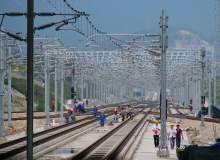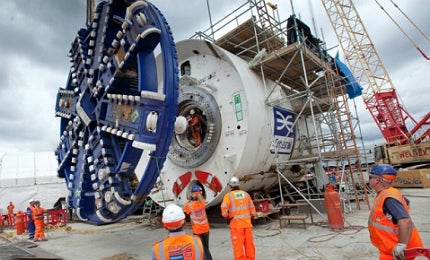
China opens world’s longest high-speed rail line
The first story of this month’s news round-up actually took place at the tail end of December, but is worth mentioning as another testament to China’s position as the world leader in high-speed rail.
On 26 December, the country opened its latest high-speed line connecting capital Beijing with Guangzhou, the capital of Guangdong Province.

Discover B2B Marketing That Performs
Combine business intelligence and editorial excellence to reach engaged professionals across 36 leading media platforms.
At 2,298km, it is the world’s longest high-speed rail line, cutting journey times between the two cities from 20 hours to just eight.
Given Guangzhou’s location near China’s southern coast, an extension to Hong Kong is now in the works. The launch of the line brings the country’s operating high-speed rail network to more than 9,300km, though the government still has a long way to go to achieve its aim of building 120,000km of high-speed rail by 2020.
China opens first subway line across Yangtze River
As well as breaking the record for the world’s longest high-speed line, China achieved another impressive feat of rail engineering at the beginning of January with the opening of Wuhan’s first subway line running underneath the Yangtze River.
Wuhan metro‘s $2.37bn Line 2 runs 27.7km and links the city’s major conurbations, Wuchang and Hanku, via a 1.3km underwater tunnel section that takes three minutes to cross the Yangtze.

US Tariffs are shifting - will you react or anticipate?
Don’t let policy changes catch you off guard. Stay proactive with real-time data and expert analysis.
By GlobalDataUnderwater tunnel construction is a major challenge, as Wuhan Metro Group’s construction manager Lin Wenshu attested: "In order to ensure safety, we took a lot of protective measures and used a large number of skilled workers to prevent ground collapses and avoid underground gases."
Renfe starts operations on Barcelona – Figueres line
China might have stolen its crown to become the reigning king of high-speed rail, but Spain is still a major proponent of the technology and is responsible for turning the Iberian Peninsula into a world-renowned hotspot for high-speed rail investment.
The 131km Barcelona – Figueres line is the country’s latest high-speed line to open, providing a high-speed link between the Catalonian capital and Figueres, near the border with France.
The line is set to play an important role in the planned link between the French and Spanish high-speed networks, which is scheduled to come into operation in April 2013.
The high-speed link will reportedly allow trains to travel from Paris to Barcelona and Madrid in six and a half hours and ten hours, respectively.
Network Rail submits £37.5bn plan for UK rail infrastructure
UK rail operator Network Rail submitted its strategic business plan to develop the country’s rail infrastructure during control period 5 (CP5), which runs from 2014 to 2019.
The plan calls for £37.5bn of investment to upgrade and modernise its rail network in the face of steadily increasing demand, as well as reduce the overall cost of operating and maintaining it in the future.
Major upcoming investments include the completion of the Thameslink upgrade programme and the surface elements of the Crossrail project, as well as large-scale electrification projects on the Great Western Main Line, the Midland Main Line and the Valleys network in Wales.
Amtrak and California to jointly procure new high-speed trains
The US is lagging behind much of the developed world in high-speed rail, but it finally appears that its two major high-speed schemes are beginning to rumble into life.
In January, Amtrak’s high-speed upgrade project on the Northeast Corridor and California’s in-development high-speed programme jointly issued a request for information (RFI) for the purchase of a common fleet of next-generation high-speed trains.
The projects are hoping to spend between $35m and $55m on each trainset, with Amtrak set to purchase 12 trains and the California High-Speed Rail Authority (CHSRA) planning to buy 35. According to US Federal Railroad Administration administrator Joseph Szabo, creating a common order will increase the chance of high-speed rail manufacturers (most of which are based in Europe or Asia) building factories in the US, secure in the knowledge that large orders will justify the investment.
Towards the end of January, CHSRA awarded a project and construction management contract to two companies to oversee work on the first stage of the California high-speed rail scheme.
Australia completes $1.05bn Southern Sydney Freight Line
Sydney’s transport officials are hoping that a major new freight line completed by Australian Rail Track Corporation (ARTC) in January will provide a major boost for both freight and passenger traffic in the city.
The 31km line between Macarthur and Leightonfield in southern Sydney will be dedicated entirely to freight traffic, allowing freight and passenger trains to operate independently, easing capacity pressure on the corridor.
According to Australian Infrastructure and Transport Minister Anthony Albanese, the completed project helps solve the rail congestion problems in Sydney, which he described as the largest bottleneck in the country’s interstate rail freight network. Around a third of the 10,000km network is currently bring rebuilt to improve transit times and reliability.
Crossrail responds to Unite’s blacklisting claims
Crossrail has roundly rejected claims by UK trade union Unite that blacklisting has occurred on London’s east-west rail construction project, one of the largest infrastructure projects in Europe.
The accusations followed the 2009 closure and subsequent investigation of the Consulting Association, an industry-funded firm that was found to be compiling lists of construction workers to be barred from working on projects such as the Olympic Park and the Jubilee Line.
The allegations stem from the testimony of Consulting Association chief executive Ian Kerr to a committee of MPs that Crossrail was a regular topic of conversation at the company before its closure. But Crossrail has denied any foul play, citing a lack of evidence and noting that the project’s first tunnelling and station contracts were awarded in December 2010, a year after the Consulting Association was closed down.
"All our contractors are fully aware that blacklisting is unlawful as well as being a breach of contract which would result in immediate action by Crossrail," said Crossrail CEO Andrew Wolstenholme.
UK’s HS2 phase two plans unveiled
Big news for the UK’s high-speed future rolled in at the end of January, as the Department for Transport unveiled its proposed route plan for the second stage of the High-Speed 2 (HS2) project.
The first phase would involve a high-speed line between London and Birmingham, while the second phase would see two branches extend the line to Crewe and Manchester on one arm, and Leeds via Derby, Nottingham and Sheffield on the other.
The plan has received a high-profile push from Prime Minister David Cameron and Chancellor of the Exchequer George Osborne, as well as broad support from the opposition Labour Party and the business community, which agree that the line will be an economic driver when completed in 2032.
However, other groups are firmly against the project, on the grounds that its benefits are vague and uncertain and the massive construction works would have a destructive effect on local residents, wildlife and countryside.













